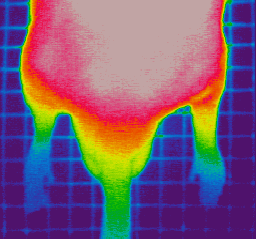| Pain Relief | ー痛みと鎮痛の基礎知識 |
|---|
しかし痛みを放置すると、さらに治療が困難な慢性痛に陥るので、
痛みを我慢してはいけない!
多くの患者さんが痛みに苦しんでいるので、
「鎮痛の研究」は望まれているに違いない。
痛みからの開放のためには、まず「痛み」を知ることも重要であろう。
 |
しかし痛みを放置すると、さらに治療が困難な慢性痛に陥るので、 痛みを我慢してはいけない! 多くの患者さんが痛みに苦しんでいるので、 「鎮痛の研究」は望まれているに違いない。 痛みからの開放のためには、まず「痛み」を知ることも重要であろう。 |
|
|
■ IASPのPainの定義 →IASP Terminology ←→ペインクリニック学会用語集 2020年の定義 1/2/3 (日本疼痛学会 1)
Dan Carr ,USA, Milton Cohen, Australia, Nanna Finnerup, Denmark, Herta Flor, Germany, Stephen Gibson, Australia, Francis Keefe, USA, Jeff Mogil, Canada, Matthias Ringkamp, USA, Kathleen Sluka, USA, Xue Jun Song, China, Bonnie Stevens, Canada, Mark D. Sullivan, USA, Takahiro Ushida, Japan
|
 An unpleasant sensory and emotional experience associated with actual or potential tissue damage, or described in terms of such damage. An unpleasant sensory and emotional experience associated with actual or potential tissue damage, or described in terms of such damage. 「痛みは、実質的または潜在的な組織損傷に結びつく、あるいはこのような損傷を表わす言葉を使って述べられる不快な感覚・情動体験である」 |
| Note: (The inability to communicate verbally does not negate the possibility that an individual is experiencing pain and is in need of appropriate pain-relieving treatment.* )Pain is always subjective. Each individual learns the application of the word through experiences related to injury in early life. Biologists recognize that those stimuli which cause pain are liable to damage tissue. Accordingly, pain is that experience we associate with actual or potential tissue damage. It is unquestionably a sensation in a part or parts of the body, but it is also always unpleasant and therefore also an emotional experience. Experiences which resemble pain but are not unpleasant, e.g., pricking, should not be called pain. Unpleasant abnormal experiences (dysesthesias) may also be pain but are not necessarily so because, subjectively, they may not have the usual sensory qualities of pain. Many people report pain in the absence of tissue damage or any likely pathophysiological cause; usually this happens for psychological reasons. There is usually no way to distinguish their experience from that due to tissue damage if we take the subjective report. If they regard their experience as pain, and if they report it in the same ways as pain caused by tissue damage, it should be accepted as pain. This definition avoids tying pain to the stimulus. Activity induced in the nociceptor and nociceptive pathways by a noxious stimulus is not pain, which is always a psychological state, even though we may well appreciate that pain most often has a proximate physical cause. 注釈: (言葉でのコミュニケーションができなくても、個人が痛みを経験している可能性があり、適切な疼痛緩和治療が必要とされる可能性がありうる。*)痛みはいつも主観的である。各個人は、生涯の早い時期の損傷に関連した経験を通じて、この言葉をどんなふうに使うかを学習している。生物学者は、痛みを引き起こす刺激はしばしば組織を損傷することを認識している。それ故、痛みはわれわれが実質的あるいは潜在的な組織損傷と関連づけた体験である。痛みは身体の一カ所あるいは複数箇所の感覚であることは疑う余地がないが、痛みはいつも不快であり、情動体験でもある。痛みに似ているが不快でない体験、たとえばチクチクした感覚は、痛みと呼ぶべきではない。不快な異常体験(異常感覚)も痛みかもしれないが、主観的には、痛みの通常の感覚特性を持たないかもしれないので、必ずしも痛みとは言い切れない。多くの人々は、組織損傷あるいは、それに相応した病態生理学的原因がないのに痛みがあると報告するが、これは通常心理的な理由で生じる。主観的な報告しか受けることができないので、このような体験と組織損傷による体験とを通常区別することはできない。 もし彼らが、自分の体験を痛みと思い、組織損傷によって生じる痛みと同じように報告するなら、それを痛みと受け入れるべきである。この定義は痛みを刺激に結びつけることに避けている。痛みを引き起こす主な原因がしばしば身体にあることを受け入れるにしても、侵害刺激によって引き起こされる、侵害受容器および侵害受容経路における活動は痛みではなく、痛みはいつも心理学状態である。 *括弧内は1979年のPain誌に掲載された時にはなく、後のIASPのウェブサイトに追加されたものである。 |
Declaration of Montréal
Declaration that Access to Pain Management Is a Fundamental Human Right We, as delegates to the International Pain Summit (IPS) of the International Association for the Study of Pain (IASP) (comprising IASP representatives from Chapters in 64 countries plus members in 130 countries, as well as members of the community), have given in-depth attention to the unrelieved pain in the world, Finding that pain management is inadequate in most of the world because: And, recognizing the intrinsic dignity of all persons and that withholding of pain treatment is profoundly wrong, leading to unnecessary suffering which is harmful; we declare that the following human rights must be recognized throughout the world: Article 1. The right of all people to have access to pain management without discrimination (Footnotes 1-4). Article 2. The right of people in pain to acknowledgment of their pain and to be informed about how it can be assessed and managed (Footnote 5). Article 3. The right of all people with pain to have access to appropriate assessment and treatment of the pain by adequately trained health care professionals (Footnotes 6-8). In order to assure these rights, we recognize the following obligations: Note: This Declaration has been prepared having due regard to current general circumstances and modes of health care delivery in the developed and developing world. Nevertheless, it is the responsibility of: governments, of those involved at every level of health care administration, and of health professionals to update the modes of implementation of the Articles of this Declaration as new frameworks for pain management are developed. Footnotes |
『モントリオール宣言』
(第9回日本運動器疼痛学会のFB ·2016年3月7日に掲載されていました。) [患者が痛みに対する適切な診療を受けることは、基本的人権であるという宣言] 我々、国際疼痛学会(International Association for the Study of Pain: IASP。64の国及び、129国の会員から構成される)の中心メンバーによる会議は、世界中で痛みが十分に治療されていないことに対し、重大な注意を喚起する。 今日においても、ほとんどの国において、未だ、疼痛に関する治療は、不十分なままである。なぜなら: そして、すべての人々の固有の尊厳を認め、かつ、痛みの治療を差し控えることは由々しき間違った行為であって不必要で有害な苦痛を招くことになるという認識のもとに、我々は下記のことを患者の基本的人権として世界中が認めなければならない、と宣言する: 第1条 すべての人々は、差別なく、痛みに対する治療を受ける権利を有する。(脚注:1-4) 第2条 痛みを有する人々は、自分の痛みを認めてもらい、かつ、痛みの評価や治療がどのように行われるかについて知ることができる権利を有する。(脚注:5) 第3条 痛みを有するすべての人々は、適切な訓練を受けた医療専門職により、過不足のない評価と治療をを受ける権利を有する。(脚注:6-8) これらの権利を確実にするため、つぎのような責務を認めるものである。 注;この宣言は、先進および発展途上国における昨今の保健衛生状況を踏まえて、用意されたものである。しかしながら、すべての政府、保健医療に携わるすべての人々、および医療専門職は、本宣言の条項を実行していくことで、痛み診療の新しいフレームワークを作り上げる責務を有する。 脚注 |
| References ANZCA. Statement on patients' rights to pain management. ANZCA PS 45; 2001. Available at: www.anzca.edu.au. Brennan F, Carr DB, Cousins MJ. Pain management: a fundamental human right. Anesth Analg 2007;105:205-21. Cousins MJ, Brennan F, Carr DB. Pain relief: a universal human right. Pain 2004:112:1-4. FEDELAT. Proclamation of pain treatment and the application of palliative care as human rights, May 22, 2008. IAHPC. Joint declaration and statement of commitment on palliative care and pain treatment as human rights. Available at: www.hospicecare.com. Scholten W, Nygren-Krug H, Zucker HA. The World Health Organization paves the way for action to free people from the shackles of pain. Anesth Analg 2007;105:1-4. Somerville M. Death of pain: pain, suffering, and ethics. In Gebhart GF, Hammond DL, Jensen TS, editors. Proceedings of the 7th World Congress on Pain. Progress in Pain Research and Management, Vol. 2. Seattle: IASP Press; 1994. p. 41-58. | |
|
← 「痛みと鎮痛の研究 - Pain Relief」の目的 |  |
|
| Since '07.9.1 | Pain Relief |